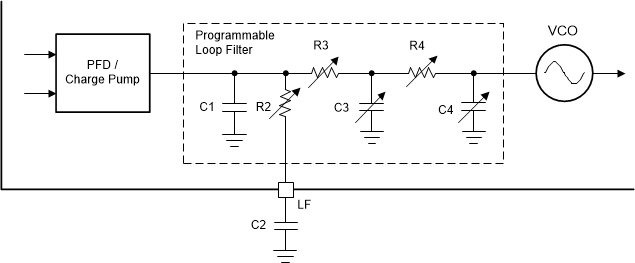SNAS835A September 2022 – February 2025 LMK5B33414
PRODUCTION DATA
- 1
- 1 Features
- 2 Applications
- 3 Description
- 4 Device Comparison
- 5 Pin Configuration and Functions
- 6 Specifications
- 7 Parameter Measurement Information
-
8 Detailed Description
- 8.1 Overview
- 8.2 Functional Block Diagram
- 8.3
Feature Description
- 8.3.1 Oscillator Input (XO)
- 8.3.2 Reference Inputs
- 8.3.3 Clock Input Interfacing and Termination
- 8.3.4 Reference Input Mux Selection
- 8.3.5 Hitless Switching
- 8.3.6 Gapped Clock Support on Reference Inputs
- 8.3.7 Input Clock and PLL Monitoring, Status, and Interrupts
- 8.3.8
PLL Relationships
- 8.3.8.1 PLL Frequency Relationships
- 8.3.8.2 Analog PLLs (APLL1, APLL2, APLL3)
- 8.3.8.3 APLL Reference Paths
- 8.3.8.4 APLL Feedback Divider Paths
- 8.3.8.5 APLL Loop Filters (LF1, LF2, LF3)
- 8.3.8.6 APLL Voltage-Controlled Oscillators (VCO1, VCO2, VCO3)
- 8.3.8.7 APLL VCO Clock Distribution Paths
- 8.3.8.8 DPLL Reference (R) Divider Paths
- 8.3.8.9 DPLL Time-to-Digital Converter (TDC)
- 8.3.8.10 DPLL Loop Filter (DLF)
- 8.3.8.11 DPLL Feedback (FB) Divider Path
- 8.3.9 Output Clock Distribution
- 8.3.10 Output Source Muxes
- 8.3.11 Output Channel Muxes
- 8.3.12 Output Dividers (OD)
- 8.3.13 SYSREF/1PPS Output
- 8.3.14 Output Delay
- 8.3.15 Clock Output Drivers
- 8.3.16 Clock Output Interfacing and Termination
- 8.3.17 Glitchless Output Clock Start-Up
- 8.3.18 Output Auto-Mute During LOL
- 8.3.19 Output Synchronization (SYNC)
- 8.3.20 Zero-Delay Mode (ZDM)
- 8.3.21 DPLL Programmable Phase Delay
- 8.3.22 Time Elapsed Counter (TEC)
- 8.4 Device Functional Modes
- 8.5 Programming
-
9 Application and Implementation
- 9.1 Application Information
- 9.2 Typical Application
- 9.3 Best Design Practices
- 9.4 Power Supply Recommendations
- 9.5 Layout
- 10Device and Documentation Support
- 11Revision History
- 12Mechanical, Packaging, and Orderable Information
Package Options
Mechanical Data (Package|Pins)
- RGC|64
Thermal pad, mechanical data (Package|Pins)
- RGC|64
Orderable Information
8.3.8.5 APLL Loop Filters (LF1, LF2, LF3)
The APLL loop filter components can be programmed to optimize the APLL LBW depending on the phase noise of the XO input. The BAW APLL supports a programmable LBW from 100Hz to 10kHz (typical range) and the conventional LC APLL supports a programmable LBW from 100kHz to 1MHz (typical range). Figure 8-24 shows the APLL loop filter structure between the PFD/charge pump output and VCO control input.
 Figure 8-24 Loop
Filter Structure of Each APLL
Figure 8-24 Loop
Filter Structure of Each APLLThe BAW APLL is configured with a narrow LBW by default in TICSPRO and the ROM pages. As a result, the low jitter VCBO dominates the clock output phase noise in the carrier offset range from 8kHz to around 400kHz.
Using the default APLL loop filter settings listed in Table 8-3, the LBW for each APLL is summarized in Table 8-4.
| COMPONENT | LOCATION | TYPE | DEFAULT VALUES FOR APLL1 | DEFAULT VALUES FOR APLL2 | DEFAULT VALUES FOR APLL3 |
|---|---|---|---|---|---|
| Charge pump | Internal | Programmable | 6.4mA | 3.4mA | 2.0mA |
| C1 | Internal | Fixed | 100pF | 100pF | 100pF |
| C2 | External(1) | Fixed | 100nF | 100nF | 470nF |
| C3 | Internal | Programmable | 70pF | 70pF | 70pF |
| C4 | Internal | Programmable | 70pF | 70pF | 70pF |
| R2 | Internal | Programmable | 0.222kΩ | 0.183kΩ | 0.301kΩ |
| R3 | Internal | Programmable | 0.657kΩ | 0.657kΩ | 5.5kΩ |
| R4 | Internal | Programmable | 0.657kΩ | 0.657kΩ | 5.5kΩ |
| APLL | VCO RANGE [MHz] | LBW [kHz](1) |
|---|---|---|
| 1 | 4800 to 5350 | 282.5 to 291.8 |
| 2 | 5600 to 5950 | 152.8 to 137.8 |
| 3 | 2500 | 4.9 |